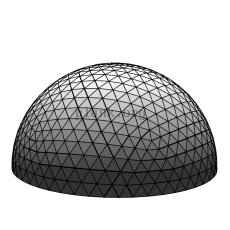
A "geodesic" dome
In order to build the 3D simulation program for the dome, I had to figure out what the structure of our dome actually is. I'd like to share what I learned about geodesic domes.

A "geodesic" dome
The invention of the
geodesic dome
is credited to
Buckminster
Fuller but is reported to have been invented 25 years earlier by
Walter Bauerfeld for work on a planetarium projector at Carl Zeiss
optics.
 |
 |
|
In case you want it, here's a
text file of the corners, edges, and triangles that make up an
icosahedron.
Triangles are structurally very strong. If you lean on one of the corners of a triangle made from three pipes bolted together, the only way it can collapse is if one of the pipes actually buckles or if a nut completely shears off of a bolt. It's much stronger than a rectangle; a rectangle of pipes and bolts could collapse if the bolts slip, which is much more likely than a shear. The canopy thingy I bought from Sears really can't stand up to the wind because it's all rectangles. (Cross-brace ropes helped somewhat in 2004 and 2005, but increased the stress on the struts.)
The force put into a corner of a triangle is directly transmitted to the base of the triangle. Since an icosahedron is made up of triangles, the force is distributed throughout the shape. The icosahedron can collapse from one of the joints between separate triangles bending, but that's still a very strong structure.
To make an icosahedron approximate a sphere more closely, the triangles making up the icosahedron are subdivided by splitting the edges of the triangle and then making the new split edges into more triangles. As in the pictures below, splitting each edge into n new edges yields n2 new triangles.
 |
 |
 |
||
The popular notation on the web for this seems to be mV, where
m is the number of new edges made from each original edge,
like 2v, 3v, 4v, etc...
If the corners of the new triangles are then moved out to the surface of a sphere centered on the icosahedron, you get something that looks more and more like a sphere the more the triangles are split. These are called "geodesic spheres". Here are geodesic spheres where the initial edges are split into 2 edges (resulting in 80 triangles), 3 edges (180 new triangles), and 4 edges (320 new triangles). I've thrown in one with 10 new edges from each initial edge, yielding 2000 triangles, 100 for each original triangle on the icosahedron.
 |
 |
|
(80 triangles) |
(180 triangles) |
 |
 |
|
(320 triangles) |
(2000 triangles) |
To make a geodesic dome, you cut a geodesic sphere in half.
Spheres with an odd degree (1v, 3v, 5v, etc...) can't actually be cut exactly in half. There's a ring of triangles that span the middle of the sphere, so typically you choose to split either just above or below that ring. For 3v domes, the popular name on the web for splitting above or below the ring seems to be "3/8" and "5/8", respectively. Here are pictures of 2v, 3/8 3v, 5/8 3v, 4v, and 10v geodesic domes.
 |
 |
 |
||
 |
 |
|
(I'm not really sure why the two variants of the 3v domes are
called "3/8" and "5/8". There are 9
edges in a zig-zag from the top of a 3v sphere to the bottom, so it seems
to me like "4/9" and "5/9" would be better names.)
 |
 |
 |
||
This is why sites like
Desert Domes are so useful to dome
builders; the Desert Domes site provides the ratios of strut lengths for
domes of the most common degrees.
You can see that there are only three unique lengths; 1.00, 1.15, and 1.18 meters. One way to provide an easy template for building such a dome is to color code the struts, and provide a diagram of how the final dome looks with colored struts. For example, let's color the 1.18-meter struts green, the 1.15-meter struts orange, and the 1-meter struts blue.
 |
 |
|
As an aside, if you were to make a "5/8" 3v dome with struts of 1, 1.15, and
1.18 meters, the dome would be 5.7 meters across. (nearly 19 feet)
Our domes at Burning Man were 5/8 3v domes. I've prepared a text file with the geometry of a 5/8 3v dome , in case you want it. Here are a pair of images showing those kind of domes with color-keyed struts.
 |
 |
|
One way to construct a dome is to cut lengths of pipe (steel pipe or
electrical conduit if strength is less important), crimp the ends, drill
holes through the ends, and then bolt all the pipes together at the dome
corners. This seems to be very popular, probably because it's easy.
The pipes can
also be bolted to plates that form the corners of the dome, but this takes
a little more work and is slightly less stable with only one hole in each
end of each pipe.
Here's a picture of the Karma Chickens' dome at Burning Man 2006, made from bolted-together electrical conduit, with dome coverings on it and a little storage quonset attached to it. I don't take any credit for this dome; it and another just like it were designed long before I joined the Karma Chickens' camp. At least this year I did help raise the domes on the playa.

(We didn't finish the lighting project. Maybe next year I'll have pictures of that.)
Last modified:
Sun Oct 1 12:25:57 PDT 2006